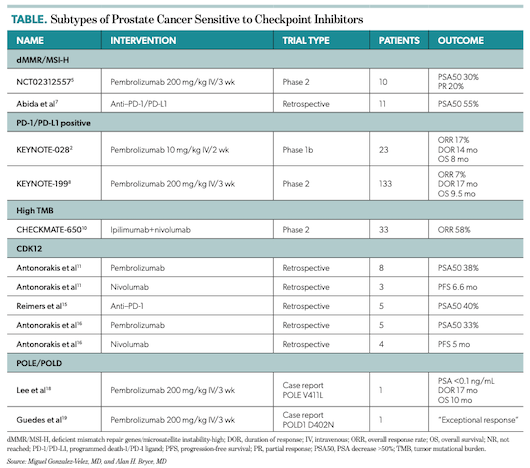Publication
Article
Urology Times Urologists in Cancer Care
How to approach immune checkpoint inhibitor therapy in prostate cancer
Author(s):
Next-generation sequencing identifies subtypes that may benefit from immune checkpoint inhibitors.
The use of immune checkpoint inhibitors (CPIs) has transformed cancer care in the last decade, but prostate cancer has not yet joined the immunotherapy revolution despite many clinical trials. Most recently, the IMbassador 250 study of atezolizumab (Tecentriq) added to enzalutamide (Xtandi) (NCT03016312) showed no benefit to adding atezolizumab.
Although it is clear that most patients with prostate cancer do not benefit from the currently available CPIs, it is nevertheless apparent that certain molecular subtypes of metastatic castrate-resistant prostate cancer (mCRPC) that can benefit from immunotherapy can be identified by genomic testing. We have many good new treatments for prostate cancer, but metastatic disease remains incurable and will be the cause of death for most patients. They will die from prostate cancer, not just with it. As long as that remains true, interest in immunotherapy for prostate cancer will remain high.
Although the ideal answer to this interest is to enroll patients in clinical trials, there are still scenarios in which nontrial treatment is the best available option. What follows is our approach to CPIs in patients with advanced prostate cancer.
The role of next-generation sequencing
Biologic differences in gene expression profiling and the presence of germline and somatic mutations exist in men with prostate cancer. National Comprehensive Cancer Network guidelines now recommend germline testing for all men with high-risk, very high-risk, or metastatic prostate cancer. We also conduct somatic (tumor) testing of all patients with metastatic disease and retesting whenever progression develops on a line of systemic therapy.
The adoption of genomic profiling with next-generation sequencing (NGS) has proven that there is significant diversity of mutational patterns in the tumors of men with metastatic prostate cancer.1,2 Genetic testing can identify patients who would benefit from PARP inhibitors such as olaparib (Lynparza) and rucaparib (Rubraca), and it can also identify patients whose tumors are more likely to respond to CPIs. These subtypes have a common characteristic of having mutations associated with DNA repair defects3 and include deficient mismatch repair genes (dMMR)/microsatellite instability-high (MSI-H), overexpression of PD-1 T-cell receptor and its ligand (PD-L1), high tumor mutational burden (TMB), and tumors with CDK12 mutations.4
Although CPIs are less toxic for the average patient than chemotherapy, they are not benign and carry a small but real risk of treatment-related mortality and a 10% to 20% risk of hospitalization across many studies. They are also expensive therapies that have to be given intravenously (IV). However, we believe in being thoughtful about when and to whom we recommend CPIs (Table) and limit them to patients whose genomics suggest a meaningful chance of response.
Subtypes of prostate cancer responsive to CPIs
dMMR/MSI-H. Tumors that lack the dMMR mechanism are hypermutated compared with tumors without such MMR defects, and the neoantigens from these additionalmutations are more immunogenic. The use of NGS is encouraged to look for dMMR/MSI-H in all patients with advanced prostate cancer. Pembrolizumab (Keytruda) received a blanket FDA approval for patients with dMMR/MSI-H prostate cancer that progressed on prior treatments.5 An initial study in mCRPC showed clinical response in a patient with dMMR/MSI-H, treated with combination pembrolizumab and enzalutamide, suggesting that a high neoantigen load could predict responses to CPIs.6

In a subsequent case series focusing on mCRPC, a minority of 3.1% (32 patients) had dMMR/MSI-H PC. Among the 11 patients who received PD-1/PD-L1 therapy, 55% had a decline in prostate-specific antigen (PSA), and 45% achieved a durable clinical benefit for as long as 19 months.7
Overexpression of PD-1/PD-L1. The open-label basket phase 1b KEYNOTE-028 trial studied pembrolizumab 10 mg/kg IV every 2 weeks for 24 months. It included 245 patients with mCRPC; 35 (14%) were positive for PD-L1. Among the 23 of 35 patients who were positive for PD-L1 who received pembrolizumab, the overall response rate (ORR) was 17%, with stable disease in 35%, progressive disease in 39%, median duration of response of 13.5 months, and median overall survival of 8 months. These findings were confirmed by KEYNOTE-199, a phase 2 trial using pembrolizumab 200 mg IV every 3 weeks for 21 cycles in 539 patients with docetaxel-refractory mCRPC.8 This study showed a PD-L1 overexpression of 32% in mCRPC and 8% in primary prostate cancer.8 In the PD-L1-positive cohort including 133 patients, there was an ORR of 7%, a median duration of response (mDOR) of 16.8 months, a complete response (CR) in 2 patients, and a median overall survival of 9.5 months.8
Of note, studies exploring PD-1/PD-L1 expression in prostate cancer use different techniques and thresholds, which result in highly variable frequencies of positivity. In summary, these combined results suggest that up to 32% of advanced prostate cancers may use the PD-L1 pathway to escape immune system detection. Patients with mCRPC and the PD-L1 subtype have a small but meaningful and sometimes durable benefit from single-agent pembrolizumab.
High TMB. Patients with mCRPC seem to have a higher TMB compared with patients earlier in the disease course.9 In general, the tumors with higher TMB correlate with dMMR. A preliminary report from the CHECKMATE 650 trial (NCT029855957) using combination ipilimumab (Yervoy) and nivolumab (Opdivo) had better outcomes in patients with high TMB compared with low TMB (TMB cutoff not reported). Results showed an ORR of 58% in both chemotherapy-naive (60% vs 0%) and after taxane based-chemotherapy (50% vs 0%).10
Biallelic CDK12 mutation. CDK12 is a tumor suppressor protein involved in genomic stability.10 Preclinical studies have suggested that biallelic CDK12 mutations are associated with higher neoantigens, tumor-infiltrating lymphocytes, and higher sensitivity to CPIs.12,13 An initial retrospective study demonstrated CPI sensitivity in 8 patients receiving PD-1 inhibitors as fourth- to sixth-line treatment. These heavily pretreated patients had a 38% PSA decline of more than 50% and a median PFS of 6.6 months.14 These results were corroborated in a retrospective study with 46 patients with CDK12 mutations (34 biallelic mutations). In a cohort of 5 patients treated with a PD-1 inhibitor, 40% achieved a PSA response.15
Finally, a larger retrospective multicenter study included 60 patients with prostate cancer who had somatic loss-of-function CDK12 mutations. Nine patients were treated with a PD-1 inhibitor (5 with pembrolizumab, 4 with nivolumab) as 4th- to 6th-line treatment, with 33% having a PSA response and median PFS of 5.4 months.16 An ongoing prospective clinical trial (NCT03570619) is examining the predictive role of CDK12 as a biomarker for the use of CPI in prostate cancer.
POLE and POLD mutations. Selected POLE and POLD mutations can generate tumors associated with very high TMB without MSI-H. These mutations have been found in about 2% of prostate cancers.17 A case report has been described in an exceptional responder to pembrolizumab with a documented POLE V411L mutation.18 Similarly, a patient with a POLD1 D402N, MSH2 mutation, and high TMB has been reported with a good clinical response to pembrolizumab.19
Conclusions
In our practice, we actively sort patients onto different treatment paths based on the genetic signature of their tumors. A small but meaningful percentage of patients will have genetic aberrations that predict responsiveness to CPIs, and the results for those lucky patients can be dramatic. We try to enroll patients on immunotherapy trials as much as possible. These trials often involve combinations of existing drugs but may also involve entirely new drugs that will be more effective for mCRPC.
We recently reported results from a phase 1 study of PT-112 in patients with a median of 6.5 lines of prior therapy. In this trial, 10 patients treated with PT-112 had a median overall survival of 15.1 months. We have also combined PT-112 with avelumab (Bavencio), with accrual to that study ongoing.20
There are many possibilities yet to explore, and we need to find a way to expand immunotherapy to all patients with mCRPC. In the meantime, NGS can identify the patients who are most likely to respond to CPIs while also identifying patients who carry an inherited cancer susceptibility gene and patients who will benefit from PARP inhibitors.
Gonzalez-Velez is a hematology/oncology fellow at Mayo Clinic, Phoenix, Arizona, and Bryce is an associate professor of medicine at Mayo Clinic, Phoenix, Arizona.
References
1. Chung JH, Dewal N, Sokol E, Mathew P, Whitehead R, Millis SZ, et al. Prospective comprehensive genomic profiling of primary and metastatic prostate tumors. JCO Precis Oncol. 2019;3
2. Hansen AR, Massard C, Ott PA, et al. Pembrolizumab for advanced prostate adenocarcinoma: findings of the KEYNOTE-028 study. Ann Oncol. 2018;29(8):1807-13
3. Campbell BB, Light N, Fabrizio D, Zatzman M, Fuligni F, de Borja R, et al. Comprehensive analysis of hypermutation in human cancer. Cell. 2017;171(5):1042-56.e10
4. Fay AP, Antonarakis ES. Blocking the PD-1/PD-L1 axis in advanced prostate cancer: are we moving in the right direction? Ann Transl Med. 2019;7(suppl 1):S7
5. Le DT, Uram JN, Wang H, Bartlett BR, Kemberling H, Eyring AD, et al. PD-1 blockade in tumors with mismatch-repair deficiency. N Engl J Med. 2015;372(26):2509-2520
6. Graff JN, Alumkal JJ, Drake CG, Thomas GV, Redmond WL, Farhad M, et al. Early evidence of anti-PD-1 activity in enzalutamide-resistant prostate cancer. Oncotarget. 2016;7(33):52810-52817
7. Abida W, Cheng ML, Armenia J, Middha S, Autio KA, Vargas HA, et al. Analysis of the prevalence of microsatellite instability in prostate cancer and response to immune checkpoint blockade. JAMA Oncol. 2019;5(4):471-478
8. Antonarakis ES, Piulats JM, Gross-Goupil M, Goh J, Ojamaa K, Hoimes CJ, et al. Pembrolizumab for treatment-refractory metastatic castration-resistant prostate cancer: multicohort, open-label phase II KEYNOTE-199 study. J Clin Oncol. 2020;38(5):395-405.
9. Ryan MJ, Bose R. Genomic alteration burden in advanced prostate cancer and therapeutic implications. Front Oncol. 2019;9:1287
10. Sharma P, Pachynski RK, Narayan V, Flechon A, Gravis G, Galsky MD, et al. Initial results from a phase II study of nivolumab (NIVO) plus ipilimumab (IPI) for the treatment of metastatic castration-resistant prostate cancer (mCRPC; CheckMate 650). J Clin Oncol. 2019;37(7_suppl):142
11. Antonarakis ES. Cyclin-dependent kinase 12, immunity, and prostate Cancer. N Engl J Med. 2018;379(11):1087-1089
12. Wu YM, Cieślik M, Lonigro RJ, Vats P, Reimers MA, Cao X, et al. Inactivation of CDK12 delineates a distinct immunogenic class of advanced prostate cancer. Cell. 2018;173(7):1770-82.e14
13. Barrero M, Rediti M, Crespo M, Dolling D, Rescigno P, Messina C, et al. Tumor-infiltrating lymphocytes in biallelic-CDK12 mutated prostate cancer. J Clin Oncol. 2018;36(15_suppl):5070
14. Antonarakis ES, Isaacsson Velho P, Agarwal N. CDK12-altered prostate cancer: clinical features and therapeutic outcomes to standard systemic therapies, PARP inhibitors, and PD1 inhibitors. Paper presented at: European Society of Medical Oncology Annual Meeting; September 29, 2019; Barcelona, Spain. Accessed May 27, 2020. https://oncologypro.esmo.org/meeting-resources/esmo-2019-congress/CDK12-altered-prostate-cancer-Clinical-features-and-therapeutic-outcomes-to-standard-systemic-therapies-PARP-inhibitors-and-PD1-inhibitors
15. Reimers MA, Yip SM, Zhang L, Cieslik M, Dhawan M, Montgomery B, et al. Clinical Outcomes in Cyclin-dependent Kinase 12 Mutant Advanced Prostate Cancer. Eur Urol. 2020;77(3):333-41
16. Antonarakis ES, Velho PI, Fu W, Wang H, Agarwal N, Santos VS, et al. CDK12-altered prostate cancer: clinical features and therapeutic outcomes to standard systemic therapies, poly (ADP-ribose) polymerase inhibitors, and PD-1 inhibitors. JCO Precis Oncol. 2020(4):370-381
17. Wang F, Zhao Q, Wang YN, Jin Y, He MM, Liu ZX, et al. Evaluation of POLE and POLD1 mutations as biomarkers for immunotherapy outcomes across multiple cancer types. JAMA Oncol. 2019;5(10):1504-1506
18. Lee L, Ali S, Genega E, Reed D, Sokol E, Mathew P. Aggressive-variant microsatellite-stable POLE mutant prostate cancer with high mutation burden and durable response to immune checkpoint inhibitor therapy. JCO Precis Oncol. 2018;(2):1-8
19. Guedes LB, Antonarakis ES, Schweizer MT, Mirkheshti N, Almutairi F, Park JC, et al. MSH2 loss in primary prostate cancer. Clin Cancer Res. 2017;23(22):6863-6874
20. Bryce AH, Costello BA, Infante JR, Ames TD, Jimeno J, Karp DD. PT-112 in advanced metastatic castrate-resistant prostate cancer (mCRPC), as monotherapy or in combination with PD-L1 inhibitor avelumab: findings from two phase I studies. Poster presented at: 2020 Genitourinary Cancers Symposium; February 13, 2020; Chicago, IL. J Clin Oncol. 2020;(supplement 6), abstract 83. Accessed May 27, 2020. doi:10.1200/JCO.2020.38.6_suppl.83






















